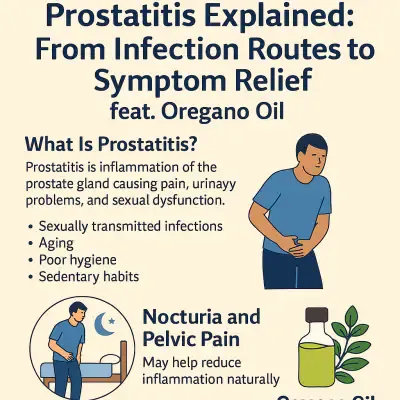What Is Prostatitis? Causes and Overview
Prostatitis refers to inflammation of the prostate gland, leading to pain,
uri
nation issues, and sometimes sexual dysfunction. The causes are
diverse, ranging from
bacterial infections, immune responses, nerve hypersensitivity, to
sexually transmitted infections (STIs).
4 Common Types of Prostatitis
-
Acute Bacterial Prostatitis
Sudden onset of symptoms including high fever, painful urination, and perineal pain. -
Chronic Bacterial Prostatitis
Recurring infections with lingering discomfort and difficulty in treatment. -
Chronic Non-Bacterial Prostatitis / Chronic Pelvic Pain Syndrome (CPPS)
Most common type; origin often unknown but may involve nerve dysfunction or immune factors. -
Asymptomatic Inflammatory Prostatitis
No noticeable symptoms, but inflammation is detected in semen or biopsy.
STI-Linked Prostatitis: A Hidden Risk
Infection via STIs
Sexually transmitted infections like Chlamydia, Gonorrhea, Mycoplasma, and Trichomonas can travel through the urethra and infect the prostate.
Research-Based Insight
According to a 2019 study in Sexually Transmitted Infections (DOI: 10.1136/sextrans-2019-054321), 27% of men with STI infections also experienced prostatitis symptoms, with Chlamydia being the most commonly linked pathogen.
Delayed diagnosis or treatment of Chlamydia-related prostatitis may result in complications like infertility.
Prevention Tips
-
Always use condoms during sexual activity.
-
Undergo routine STI testing, especially with multiple partners.
-
Limit number of sexual partners and maintain good genital hygiene.
Why Office and Driving Jobs Raise Risk
Perineal Pressure and Reduced Blood Flow
The prostate lies directly beneath the bladder and behind the pubic bone—an area that's under constant pressure when seated. Prolonged sitting leads to reduced blood circulation, encouraging inflammation.
Supporting Studies and Real-Life Cases
-
A 2022 article in Urology Journal noted that sedentary workers are 2.5 times more likely to develop prostatitis than active workers.
-
NIH findings show that men who sit more than 6 hours a day report higher rates of pelvic pain and urinary discomfort.
-
Case in point: long-haul truck drivers frequently report chronic pelvic pain and urinary urgency linked to prostatitis.
Can Shared Towels or Public Baths Cause Prostatitis?
Public Hygiene and Risk of Infection
Though less common, prostatitis can result from bacterial exposure via shared items or unsanitary environments. Public bathhouses or shared towels, particularly when the skin or urethra is irritated or wounded, can introduce pathogens.
Expert Commentary
According to the Korean Urological Association:
-
Cases of prostatitis related to bathhouse exposure are rare but documented.
-
Weakened immunity significantly increases susceptibility.
Practical Advice
-
Avoid using shared towels; bring your own.
-
Pay attention to hygiene conditions at public baths.
-
Practice thorough cleansing after exposure to public facilities.
Prostatitis and Aging: Are They Related?
Benign Prostatic Hyperplasia (BPH) and Inflammation
As men age, the prostate often enlarges—a condition called BPH—which disrupts urination and can promote infections due to retained urine. BPH and prostatitis frequently coexist.
Clinical Evidence
-
Mayo Clinic reports link aging, weakened immune response, and hormone changes with higher prostatitis risk.
-
Asian Journal of Urology (2021): Older men are more prone to chronic, treatment-resistant prostatitis.
-
Age-related decline in blood flow and collagen remodeling in the prostate also contributes to inflammation.
Nighttime Urination and Post-Urination Dribbling
Waking Up to Urinate at Night
Prostatitis often involves bladder outlet inflammation, increasing bladder sensitivity. This leads to frequent urges to urinate, especially in the early morning, with a persistent sense of incomplete voiding.
How to Differentiate from Similar Conditions
| Condition | Key Symptoms |
|---|---|
| Prostatitis | Pain after urination, pelvic discomfort, reduced sexual performance |
| BPH | Weak stream, increased post-void urine, difficulty starting urination |
| Overactive Bladder | Sudden urge to urinate, frequent trips, usually without pain |
If unsure, medical diagnosis is essential.
How Oregano Oil May Help Relieve Prostatitis Symptoms
Potent Natural Compounds
Oregano oil contains Carvacrol and Thymol, both known for their anti-inflammatory and antibacterial activity.
Scientific Findings
-
Phytotherapy Research (2019) found that oregano oil suppressed pro-inflammatory cytokines like IL-6 and TNF-α.
-
Journal of Applied Microbiology (2020) confirmed oregano oil’s potent antimicrobial effect against E. coli and Staphylococcus aureus—common prostatitis pathogens.
-
Animal studies showed over 40% reduction in inflammatory markers.
How to Use It
-
Capsules: Take 150mg once or twice daily after meals.
-
Liquid Drops: Mix with a carrier oil for safe use.
-
Topical: Dilute and massage gently around the lower abdomen or perineum.
⚠️ Consult a physician before use, especially if you take blood thinners or have digestive issues.
Lifestyle Habits That Make a Difference
-
Get up every hour for light stretching or walking.
-
Use a donut-shaped cushion to relieve perineal pressure.
-
Eat anti-inflammatory foods like broccoli, tomato, green tea, and ginger.
-
Practice Kegel exercises and pelvic floor stretches.
-
Improve sleep quality (7–8 hours) and manage stress through breathing techniques or meditation.
Final Thoughts: A Holistic Approach to Prostatitis Management
Prostatitis is not caused by one single factor—it results from a combination of infections, aging, lifestyle, and hygiene. Oregano oil is a promising natural remedy that may relieve symptoms, but it’s not a standalone cure.
For best results, pair oregano oil with professional medical care, lifestyle improvement, and stress management. Long-term prostate health requires consistency, awareness, and an integrative approach that goes beyond quick fixes.
If you'd like, I can also provide:
-
A downloadable PDF version
-
Infographic layout for social sharing
-
SEO-optimized blog formatting
Let me know how you'd like to proceed!
Recommended Articles to Read Together

